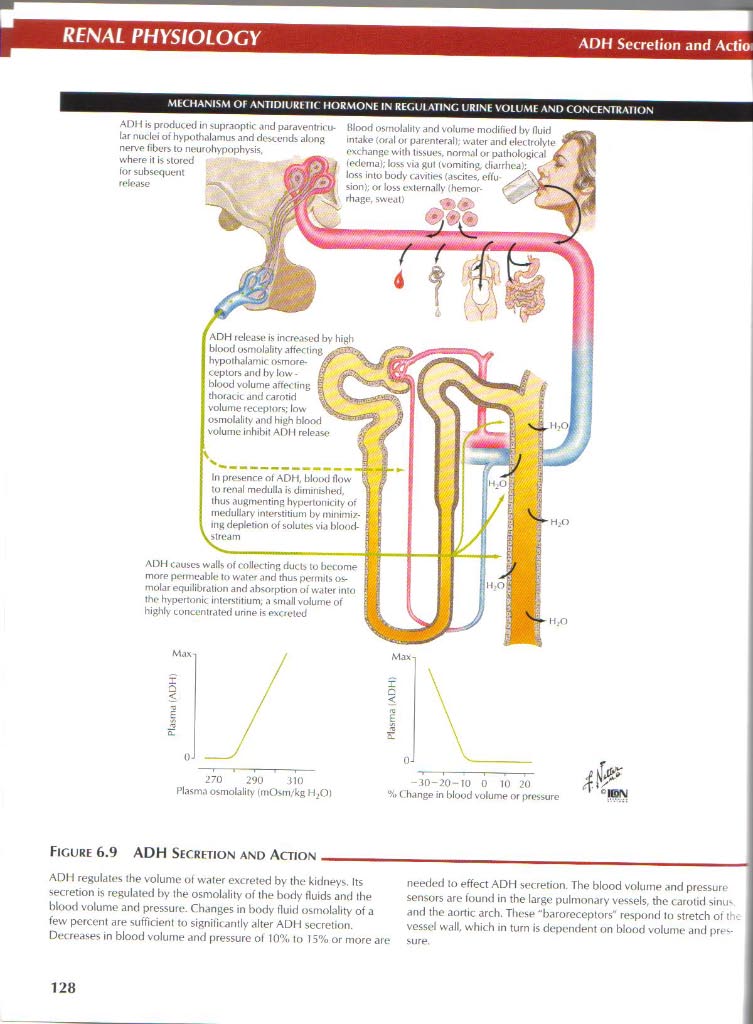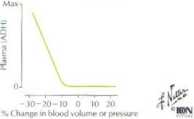26411 netter111

ADH Secrelion and Actiol
RENAL PHYSIOLOGY
MtCHANISM OF ANT1DIURETIC HORMONE IN REGUŁ ATINC URINE VOLUME AND CONCENTRAIION
ADH ii produced in iupraoptic and paraventricu lar nuclci of hypolhalamus and descends along nprvo fibers to njHirohypophysis, where it i* itorcd
Hlood o$rm>lalilv and volume modified by Fluid intake (mai 01 parenterall; water and eleclrołyle r*xchanee with tissues. norma! or uathokiuiral
ADH cauics walls of collecting ducb to become morę peimedble to water and rhus permits os-molar eąuilibralion and ahsorption of water into the hypertonic interstitium, a smali volume of bighły Loncentrated urine is ekcrcled

In presenre ot ADH, blood flow to renal meduHa i$ diminbhed, thtis augmenting hypcrtonicily of meduUary interstitium by minimiz-ing depłption of solutes via bloocł-
blood osmolality affecting hypolhalamic osmore-ceptore and by Iow -hlood volume arfceting thoracic and carotid yolume receptors; Iow osmolality and high blood volumc inhibit ADII release


270 290 310
Plasmn osmolality (mOsm/kg t-hOl
Figurę 6.9 ADH Secretion and Action
ADH regulates the volume t>ł water excreted by the kidneys. Its secretion is restulated by the osmolality of the borly fluids and the blood volume ancł pressure. Changes in body fluid osmolality of a few porc.cnt are sufficient to signiticantly alter ADH secretion. Decreases in blood volume and pressure ot 10% to 15% or morę are needed to effect ADH secretion. The blood volume and pressuri sensors are found in the large pulmonary ves$els, the carotid sinu*> and the aortic arch. Thcse "barorccepiors" respond to stretch ot th-: vesscl wali, which in tum is dependent on blood volume and pres-
128
Wyszukiwarka
Podobne podstrony:
netter155 Gallbladder Structure and FunctiunGASTROINTESTINAL PHYSIOLOGY R. and L hepatic duets R. an
netter156 GASTROINTESTINAL PHYSIOLOGY Overvievv of Cii Trać! Fluid and Electrolyte Transport Ingest
82393 netter97 RESPIRATORY PHYSIOLOGYRole of the Lungs in Acid-Base BaLar A. Role ot Lungs and Kidne
netter109 Renal Clearance: IIRENAL PHYSIOLOGY PRINCIPIE OF TUBULAR SECRETION LIMITATION (Tm) USINC P
netter116 i ^sponse to Decreased ECFRENAL PHYSIOLOGY T Volume contraction 1
netter138 Smali Intestine Slructure: IGASTROINTESTINAL PHYSIOLOGY Figurę 7.16 Small Intfstine Struct
netter158 GASTROINTESTINAL PHYSIOLOGY Digestion of Carbohydrales Maftose Pancreatic amyiase
netter161 Overview of Hormone ActionENDOCRINE PHYSIOLOGY Steroid Hnrmones Thyroid Hormones Vita
netter165 ENDOCRINE PHYSIOLOGY Posterior Pituilary: Oxytocin Oxyto<in pickcd up by capillaries of
netter44 Skeletal Musde: Sarcoplasmic RełiculumMUSCLE PHYSIOLOGY Segment ot musde fiber greatly enla
netter49 I I Cardiac Mustlt*: StructureMUSCLE PHYSIOLOGYFlCURF 3.7 SCHEMA OF STRUCFURt OF CARDIAC MU
więcej podobnych podstron